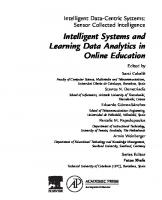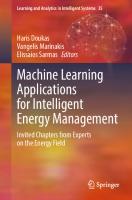Automated Software Engineering: A Deep Learning-Based Approach (Learning and Analytics in Intelligent Systems, 8) 9783030380052, 9783030380069, 303038005X
This book discusses various open issues in software engineering, such as the efficiency of automated testing techniques,
141 51 3MB
English Pages 129 [125]
Table of contents :
Preface
Acknowledgements
Contents
1 Selection of Significant Metrics for Improving the Performance of Change-Proneness Modules
1.1 Introduction
1.2 Experiment Dataset
1.3 Framework for Software Metrics Validation
1.4 Classification Techniques
1.5 Experimental Setup
1.6 Analysis of Results
1.6.1 Artificial Neural Network (ANN) Model
1.6.2 Ensembles of Classification Models
1.6.3 Comparison of Results
1.7 Conclusion
References
2 Effort Estimation of Web Based Applications Using ERD, Use Case Point Method and Machine Learning
2.1 Introduction
2.2 Literature Review
2.3 Overview of the Chapter
2.3.1 Problem Statement
2.3.2 Data Set Used
2.4 Proposed Work with Estimating the Size
2.4.1 DSPBERD Metric
2.4.2 UCPt Method
2.5 Effort Estimation of the Web-Based Application
2.6 Effort Estimation Using Machine Learning
2.6.1 Data Set Used for Training Purposes
2.6.2 Support Vector Machine (SVM)
2.6.3 Nearest Neighbour Algorithm
2.7 Conclusion and Future Work
References
3 Usage of Machine Learning in Software Testing
3.1 Introduction
3.2 Background: Software Vulnerability Analysis and Discovery
3.2.1 Definition
3.2.2 Completeness, Soundness and Undecidable
3.2.3 Conventional Approaches
3.2.4 Categorizing Previous Work
3.3 Vulnerability Prediction Based on Software Metrics
3.4 Anomaly Detection Approaches
3.5 Vulnerable Code Pattern Recognition
3.6 System and Method for Automated Software Testing Based on Machine Learning
3.6.1 System for Automated Software Testing
3.6.2 Method for Automated Software Testing
3.7 Summary of the Techniques
3.8 Conclusion
References
4 Test Scenarios Generation Using Combined Object-Oriented Models
4.1 Introduction
4.2 Basic Terminology
4.2.1 Test Scenarios
4.2.2 Sequence Diagram
4.2.3 State Machine Diagram
4.2.4 Test Coverage Criteria
4.2.5 Bio Inspired Meta-heuristic Algorithm for Object-Oriented Testing
4.3 Literature Survey
4.4 Proposed Model
4.4.1 Construction of the Sequence and State-Machine Diagram of System
4.4.2 Generate Individual Graphs of the Sequence and State-Machine Diagram
4.4.3 Generate Combined Intermediate Graph Named as State-Sequence Intermediate Graph
4.4.4 Generate the Test Scenarios SSIG
4.5 Implementation and Result Analysis
4.5.1 Generate the Test Scenarios SSIG
4.5.2 Construction of Combined State-Sequence Intermediate Graph (SSIG)
4.5.3 Generation of Test Scenarios
4.5.4 Observed Test Cases
4.5.5 Analysis of Result
4.6 Conclusion
References
5 A Novel Approach of Software Fault Prediction Using Deep Learning Technique
5.1 Introduction
5.2 Related Work
5.3 Basic Concepts
5.3.1 Deep Learning
5.3.2 Basic Deep Learning Terminologies
5.3.3 Deep Learning Models
5.4 Fault Localization Using CNN
5.4.1 Framework Overview
5.4.2 Experimental Setup and Example Program
5.4.3 Procedure of Fault Localization Using CNN
5.5 Conclusion and Future Work
References
6 Feature-Based Semi-supervised Learning to Detect Malware from Android
6.1 Introduction
6.2 Related Work
6.2.1 Research Questions
6.3 Data Set Description
6.4 Feature Sub-set Selection Approaches
6.4.1 Consistency Sub-set Evaluation Approach
6.4.2 Filtered Sub-set Evaluation
6.4.3 Rough Set Analysis Approach
6.4.4 Feature Sub-set Selection Approach Based on Correlation
6.5 Machine Learning Classifiers
6.6 Proposed Detection Framework
6.7 Evaluation of Parameters
6.8 Experimental Setup
6.9 Outcomes of the Experiment
6.9.1 Feature Sub-set Selection Approaches
6.9.2 Machine Learning Classifier
6.9.3 Comparison of Outcomes
6.9.4 Evaluation of Proposed Framework Using Proposed Detection Framework
6.9.5 Experimental Finding
6.9.6 Conclusion
References
Preface
Acknowledgements
Contents
1 Selection of Significant Metrics for Improving the Performance of Change-Proneness Modules
1.1 Introduction
1.2 Experiment Dataset
1.3 Framework for Software Metrics Validation
1.4 Classification Techniques
1.5 Experimental Setup
1.6 Analysis of Results
1.6.1 Artificial Neural Network (ANN) Model
1.6.2 Ensembles of Classification Models
1.6.3 Comparison of Results
1.7 Conclusion
References
2 Effort Estimation of Web Based Applications Using ERD, Use Case Point Method and Machine Learning
2.1 Introduction
2.2 Literature Review
2.3 Overview of the Chapter
2.3.1 Problem Statement
2.3.2 Data Set Used
2.4 Proposed Work with Estimating the Size
2.4.1 DSPBERD Metric
2.4.2 UCPt Method
2.5 Effort Estimation of the Web-Based Application
2.6 Effort Estimation Using Machine Learning
2.6.1 Data Set Used for Training Purposes
2.6.2 Support Vector Machine (SVM)
2.6.3 Nearest Neighbour Algorithm
2.7 Conclusion and Future Work
References
3 Usage of Machine Learning in Software Testing
3.1 Introduction
3.2 Background: Software Vulnerability Analysis and Discovery
3.2.1 Definition
3.2.2 Completeness, Soundness and Undecidable
3.2.3 Conventional Approaches
3.2.4 Categorizing Previous Work
3.3 Vulnerability Prediction Based on Software Metrics
3.4 Anomaly Detection Approaches
3.5 Vulnerable Code Pattern Recognition
3.6 System and Method for Automated Software Testing Based on Machine Learning
3.6.1 System for Automated Software Testing
3.6.2 Method for Automated Software Testing
3.7 Summary of the Techniques
3.8 Conclusion
References
4 Test Scenarios Generation Using Combined Object-Oriented Models
4.1 Introduction
4.2 Basic Terminology
4.2.1 Test Scenarios
4.2.2 Sequence Diagram
4.2.3 State Machine Diagram
4.2.4 Test Coverage Criteria
4.2.5 Bio Inspired Meta-heuristic Algorithm for Object-Oriented Testing
4.3 Literature Survey
4.4 Proposed Model
4.4.1 Construction of the Sequence and State-Machine Diagram of System
4.4.2 Generate Individual Graphs of the Sequence and State-Machine Diagram
4.4.3 Generate Combined Intermediate Graph Named as State-Sequence Intermediate Graph
4.4.4 Generate the Test Scenarios SSIG
4.5 Implementation and Result Analysis
4.5.1 Generate the Test Scenarios SSIG
4.5.2 Construction of Combined State-Sequence Intermediate Graph (SSIG)
4.5.3 Generation of Test Scenarios
4.5.4 Observed Test Cases
4.5.5 Analysis of Result
4.6 Conclusion
References
5 A Novel Approach of Software Fault Prediction Using Deep Learning Technique
5.1 Introduction
5.2 Related Work
5.3 Basic Concepts
5.3.1 Deep Learning
5.3.2 Basic Deep Learning Terminologies
5.3.3 Deep Learning Models
5.4 Fault Localization Using CNN
5.4.1 Framework Overview
5.4.2 Experimental Setup and Example Program
5.4.3 Procedure of Fault Localization Using CNN
5.5 Conclusion and Future Work
References
6 Feature-Based Semi-supervised Learning to Detect Malware from Android
6.1 Introduction
6.2 Related Work
6.2.1 Research Questions
6.3 Data Set Description
6.4 Feature Sub-set Selection Approaches
6.4.1 Consistency Sub-set Evaluation Approach
6.4.2 Filtered Sub-set Evaluation
6.4.3 Rough Set Analysis Approach
6.4.4 Feature Sub-set Selection Approach Based on Correlation
6.5 Machine Learning Classifiers
6.6 Proposed Detection Framework
6.7 Evaluation of Parameters
6.8 Experimental Setup
6.9 Outcomes of the Experiment
6.9.1 Feature Sub-set Selection Approaches
6.9.2 Machine Learning Classifier
6.9.3 Comparison of Outcomes
6.9.4 Evaluation of Proposed Framework Using Proposed Detection Framework
6.9.5 Experimental Finding
6.9.6 Conclusion
References

- Author / Uploaded
- Suresh Chandra Satapathy
- Ajay Kumar Jena
- Jagannath Singh
- Saurabh Bilgaiyan





![Designing Deep Learning Systems: A software engineer's guide [1 ed.]
1633439860, 9781633439863](https://ebin.pub/img/200x200/designing-deep-learning-systems-a-software-engineers-guide-1nbsped-1633439860-9781633439863.jpg)



